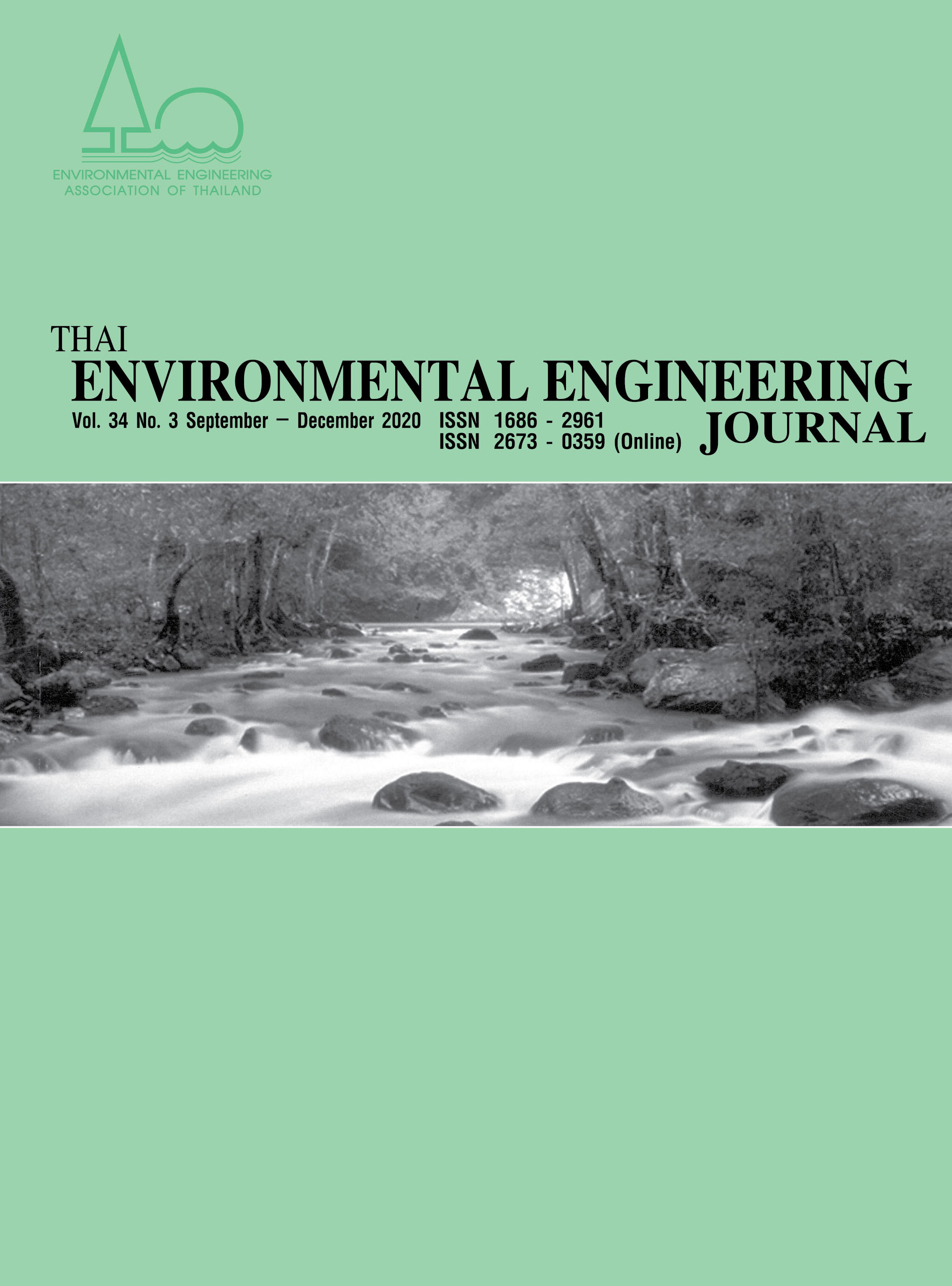Indoor Air Quality of PM2.5 in Classrooms of Science Building, Udon Thani Rajabhat University, Thailand
Main Article Content
Abstract
This work investigates for indoor air quality particulate matter 2.5 microns (PM2.5) in classrooms of Science building at the Faculty of Science, Udon Thani Rajabhat University, Thailand. The study was determined from selected five classrooms and monitored by a dust track meter during the summer (April-May 2019) and rainy season (June–July 2019). PM2.5 concentrations in summer were found between 53.1±11.10 µg/m3, which over the maximum acceptable value PM2.5 for indoor air quality in office buildings (8 hours) by the Ministry of Public Health, Thailand (35 µg/m3), while in the rainy found only 25.6±4.99 µg/m3. This indicated summer was also possibly related to the thermal inversion phenomena, which often occurs in high and low temperatures between indoor and outdoor sites. The results showed the average PM2.5 concentration in laboratory rooms (43.2±9.36 µg/m3) was higher than that of the lecture rooms (32.71 µg/m3). This is because the activity of class occurred during the laboratory lesson time. Additionally, the outdoor source caused by air pollution from sugar cane combustion near Udon Thani University can be generated the high PM2.5 (Average 91.70±21.62 µg/m3). As because of this, PM2.5 generated by particles of these activities was the critical environmental problems in the Udon Thani city. The results show that new data in Udon Thani university for the air quality (PM2.5) based on concentrations from indoor air in classroom, including caused of PM2.5 pollution is emitted from outdoor pollution sources. It is well known that air pollution constitutes the most pressing environmental health risk and environmental problems. Therefore, the data of this study to benefit for the local government and environmental organizations to reduce or prevent the concentrations of many pollutants are influenced by local in Udon Thani city.
Article Details
References
Mohammadyan, M., Larimi, A. A., Etemadinejad, S., Latif, M. T., Heibati, B., Yetilmezsoy, K., Wahab, S. A. A. and Dadvand, P. 2017. Particulate air pollution at schools: Indoor-outdoor relationship and determinants of indoor concentrations. Aerosol and Air Quality Research, 17(3): 857-864.
Chirasophon, S. and Pochanart, P. 2020. The long-term characteristics of PM10 and PM2.5 in Bangkok, Thailand. Asian Journal of atmospheric environment, 14(1): 73-83.
Martínez, L., Monsalve, S. M., Vásquez, K. Y., Orellana, S. A., Vergara, J. K., Mateo, M. M., Salazar, R. C., Alburquenque, M. F., Alcaíno, A. M., Torres, R., and Lillo, D.D.C. 2016. Indoor-outdoor concentrations of fine particulate matter in school building microenvironments near a mine tailing deposit. AIMS Environmental Science, 3(4): 752-764.
Agarwal, N. and Nagendra S. M. S. 2016. Modelling of particulate matters distribution inside the multilevel urban classrooms in tropical climate for exposure assessment. Building and Environment, 102: 73-82.
Fuoco, F. C., Stabile, L., Buonanno, G., Trassiera, C.V., Massimo, A., Russi, A., Mazaheri, M., Morawska, L. and Andrade, A. 2015. Indoor air quality in naturally ventilated Italian classrooms. Atmosphere, 6(11): 1652-1675.
Poltam, S., Kaewrueng, S., Duangpatra, P., Weerathaworn, P. and Sanglestsawai, S. 2018. Assessment of biomass loss and air pollution caused by pre-harvest sugarcane burning using the closed loop combustion system model. Environment Asia, 11(2): 1-8.
Wongaree, M. 2019. Water quality assessment by using of water quality index for Mak Khaeng canal, Udon Thani province, Thailand. EnvironmentAsia, 12(2): 96-104.
Cançado, J. E. D., Saldiva, P. H. N., Pereira, L. A. A., Lara, L. B. L. S., Artaxo, P., Martinelli, L. A., Arbex, M. A., Zanobetti, A. and Braga, A. L. F. 2006. The impact of sugar cane burning emissions on the respiratory system of children and the elderly. Environmental Health Perspective, 114(5): 725-729.
Alves, C., Nunes, T., Silva, J. and Duarte, M. 2013. Comfort parameters and particulate matter (PM10 and PM2.5) in school classrooms and outdoor Air. Aerosol and Air Quality Research, 13(5): 1521-1535.
Sohn, M., Kim, H., Sung, H., Lee, Y., Choi, H. and Chung, H. 2019. Association of social deprivation and outdoor air pollution with pulmonary tuberculosis in spatiotemporal analysis. International Journal of Environmental Health Research, 29(6): 657-667.
Hu, J., Li, N., Yoshino, H. and Yanagi, U. 2017. China Field Investigation of PM2.5 in Schoolchildren’s Houses and Classrooms in Changsha, China. Procedia Engineering, 205: 1433-1438.
Park, J. H., Lee, T. J., Park, M. J., Oh, H. and Jo, Y. M. 2020. Effects of air cleaners and school characteristics on classroom concentrations of particulate matter in 34 elementary schools in Korea. Building and Environment, 167: 106437-106448.
Polednik, B. 2013. Particulate matter and student exposure in school classrooms in Lublin, Poland. Environmental Research, 120: 134-139.
Ni, Y., Shi, G. and Qu, J. 2020. Indoor PM2.5, tobacco smoking and chronic lung diseases: A narrative review. Environmental Research, 181: 108910-108920.
Burdova, E. K., Vilcekova, S. and Meciarova, L. 2016. Tallinn and Helsinki Investigation of particulate matters of the university classroom in Slovakia. Energy Procedia, 96: 620-627.
Ohyama, M., Nakajima, T., Minejima, C., Azuma, K., Oka, K., Itano, Y., Kudo, S. and Takenaka, N. 2019. Association between indoor nitrous acid, outdoor nitrogen dioxide, and asthma attacks: results of a pilot study. International Journal of Environmental Health Research, 29(6): 632-642.
Gao, S., Hilts, R. W., Ross, M. S. and Styler, S. A. 2018. Particulate matters: student-led air quality research in the third-year environmental chemistry classroom and the field. Analytical and Bioanalytical Chemistry. 410: 3223-3229.
Department of Health. 2016. Operational Manual of Indoor Air Quality Assessment for staff. Ministry of Public Health, Thailand.


